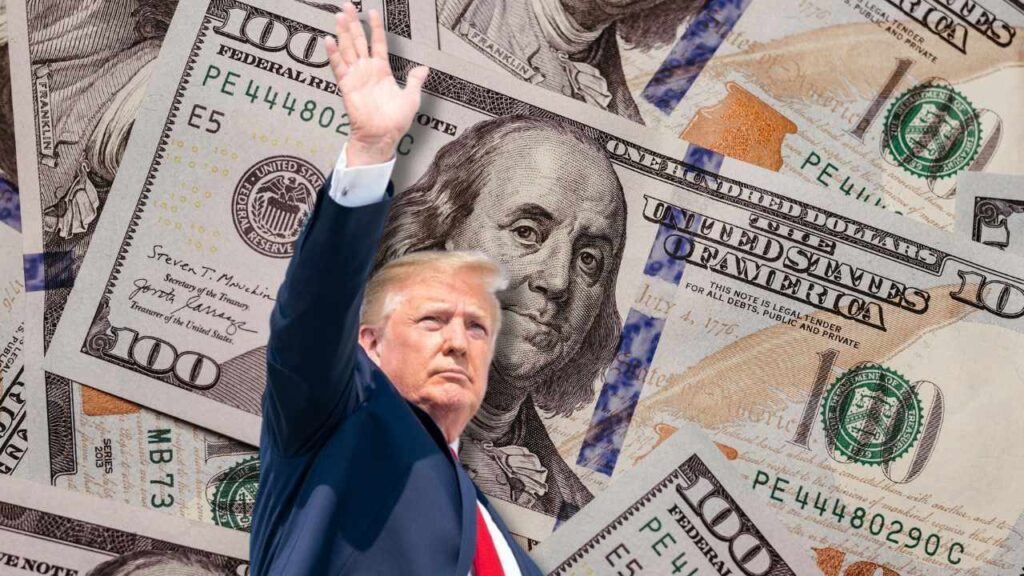President Donald Trump has revived the idea of distributing stimulus checks to Americans, this time funded by revenue from his controversial import tariffs. The proposal, floated during a rally in Ohio some weeks ago, could inject up to $2,000 per person into the economy, but faces skepticism both on Capitol Hill and in global markets.
Trump, who returned to the White House in January following his victory in the 2024 election, has championed his “America First” agenda with a series of tariffs that are already transforming the trade landscape.
Since February, his administration has imposed levies of 10 to 20 percent on all imports and tariffs of 60 percent or more on Chinese and Mexican goods, arguing that these generate “billions” in revenue for the Treasury.
Trump proposed stimulus checks up to $2,000
According to estimates by the Commerce Department, these tariffs could raise up to $2.3 trillion over the next decade, enough to cover not only federal debt but also popular initiatives like the proposed checks.
“We’re giving back to the people who earned it with sweat and tears,” Trump declared to a cheering crowd in Cleveland. These tariffs are not a punishment for anybody; they’re a way of saying ‘thank you’ to the American workers. Some of the projections are around $1,000 or $2,000 in Americans’ bank account, just for being part of this great nation.
The idea evokes the Covid-19-era stimulus checks distributed in 2020 and 2021 under his first term, which totaled more than $800 per adult and helped fuel the post-pandemic recovery.
Are these similar to the “DOGE” stimulus checks (that never landed)?
However, the proposal is not new. In February 2025, Trump dubbed it the “DOGE dividend“—a playful reference to the Department of Government Efficiency (DOGE), his joint initiative with Elon Musk to cut federal spending. At the time, he talked about checks of up to $5,000, but the plan stalled due to budget objections. Now, with the 2026 midterm elections on the horizon, analysts see this as a shrewd political calculation to galvanize his Republican base, which applauds the anti-globalization approach.
Not all is rosy on Pennsylvania Avenue. The Internal Revenue Service (IRS) issued urgent alerts this week, denying viral rumors on social media about an immediate $2,000 payment in October. “Any claim of automatic checks is a scam,” warned an official statement from the IRS, which has seen an increase in phishing attempts.
For the funds to materialize, Congress must approve not only the permanent tariffs—currently in the implementation phase—but also a stimulus package that includes these refunds, a process that could extend into the next fiscal year.
How possible are these “tariffs” stimulus checks?
Economists, for their part, warn of a double-edged sword. “Tariffs sound good in theory, but in practice they raise consumer prices by 1-2% annually, according to models from the Peterson Institute,” explains Sarah Kline, senior analyst at the Brookings Institution.
“These checks may be a temporary cure, but they don’t resolve underlying inflation or prevent a potential trade war with allies like the European Union.” In fact, Beijing has already responded with countermeasures, threatening reciprocal tariffs on US agricultural exports, which could hit Midwestern farmers—precisely the electorate Trump is seeking to win back.
On Wall Street, the reaction has been mixed: the Dow Jones rose 0.5% after Trump’s announcement, boosted by expectations of increased domestic spending, but Treasury bonds fell amid fears of ballooning deficits. Meanwhile, on Capitol Hill, Democrats like Senator Elizabeth Warren have called the idea a “sleight of hand”: “Funding giveaways to working families with hidden taxes is not politics; it’s pure populism.”
If the plan moves forward, checks could reach millions of middle- and low-income households starting in spring 2026, prioritizing those who didn’t receive pandemic payments. For Trump, it’s a high stakes bet: success could cement his economic legacy; failure could fuel criticism of instability. For now, the White House confirms that Musk’s DOGE team is “evaluating options,” but with no timeline.
